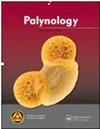阿根廷干湿查科地区单花蜂蜜的孢粉学和物理化学综述
IF 1.3
4区 地球科学
Q3 PALEONTOLOGY
引用次数: 0
摘要
摘要本文首次结合孢粉学和理化参数对干湿查科单花蜂蜜进行了表征。这项研究的重点是最具代表性的蜂蜜。对116种单花蜂蜜的颜色、电导率、水分、酸度和pH等理化参数进行了分析。所有考虑的参数都在可接受的范围内。多变量聚类分析(CA)、主成分分析(PCA)和相关分析强调,颜色和电导率是最显著的特征。颜色最深的蜂蜜(即黑色、深琥珀色和琥珀色)为产自荆芥(Tessaria integrifolia)、五味子(Schinopsis balansae)、S. lorentzii和bacchari - eupatorium型花粉的蜂蜜,颜色最浅的蜂蜜(即浅琥珀色和超浅琥珀色)为产自Cynophalla retusa、Eugenia uniflora、Copernicia alba、Prosopis alba和Helianthus annuus的蜂蜜。电导率的平均值在0.4 ~ 0.8mS cm-1之间,在颜色最深的蜂蜜中检测到的值最高,这些蜂蜜主要产自干查科。这些蜂蜜的强烈颜色也表明抗氧化剂的存在。因此,颜色、电导率和抗氧化性能是未来研究需要考虑的重要因素,以获得这些蜂蜜的植物和地理特征的可靠认证。本文章由计算机程序翻译,如有差异,请以英文原文为准。
An Overview of the Palynology and Physicochemistry of Monofloral Honeys from the Dry and Humid Chaco of Argentina
ABSTRACT This article is the first contribution to the characterization of monofloral honeys from the Dry and Humid Chaco that combines palynological and physicochemical parameters. The study focuses on the most represented honeys. Physicochemical parameters such as color, electrical conductivity, moisture, acidity and pH were analyzed for a total of 116 honeys classified as monofloral by pollen analysis. All the parameters considered were within the accepted range. Color and electrical conductivity were the most distinctive features, as stressed by multivariate (cluster analysis (CA) and principal component analysis (PCA)) and correlation analysis. The darkest honeys (i.e. black, dark amber and amber) were those from Tessaria integrifolia, Schinopsis balansae, S. lorentzii and Baccharis–Eupatorium-type pollen, and the lightest honeys (i.e. light amber and extra light amber) were those from Cynophalla retusa, Eugenia uniflora, Copernicia alba, Prosopis alba and Helianthus annuus. Mean values for electrical conductivity ranged from 0.4 to 0.8mS cm–1, with the highest values detected in the darkest honeys, which are mainly produced in the Dry Chaco. The intense color of these honeys also suggests the presence of antioxidants. Thus, the color, electrical conductivity and antioxidant properties are important factors for future research to consider, to obtain a reliable authentication of the botanical and geographical features of these honeys.
求助全文
通过发布文献求助,成功后即可免费获取论文全文。
去求助
来源期刊

Palynology
地学-古生物学
CiteScore
3.40
自引率
26.70%
发文量
48
审稿时长
>12 weeks
期刊介绍:
Palynology is an international journal, and covers all aspects of the science. We accept papers on both pre-Quaternary and Quaternary palynology and palaeobotany. Contributions on novel uses of palynology, review articles, book reviews, taxonomic studies and papers on methodology are all actively encouraged.
 求助内容:
求助内容: 应助结果提醒方式:
应助结果提醒方式:


